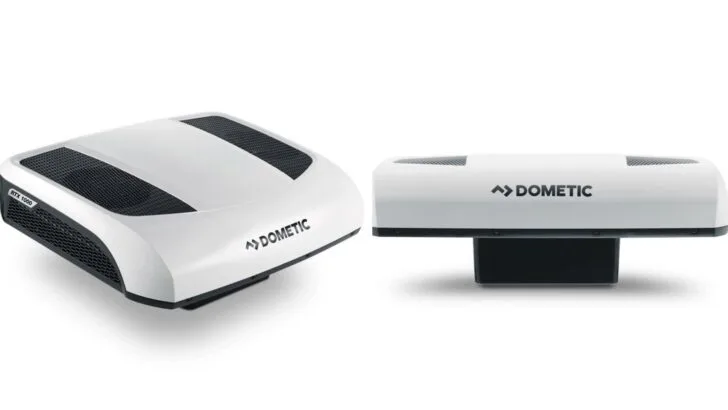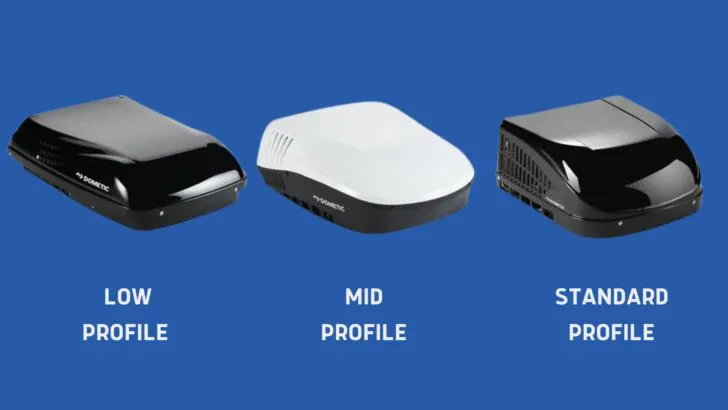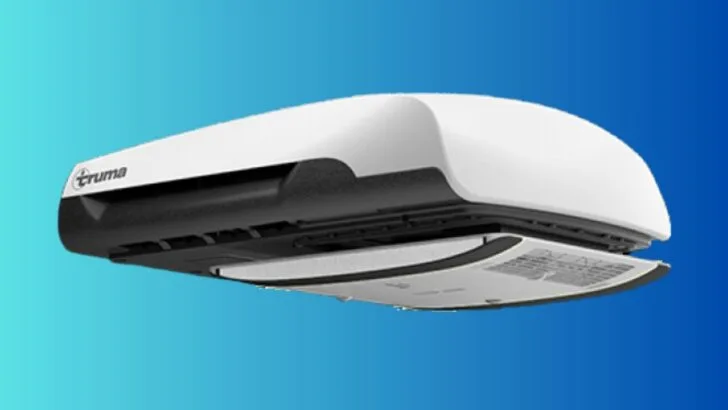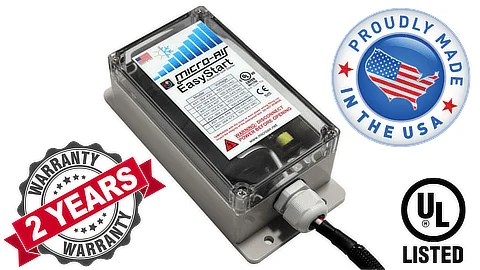One thing most RVers have in common is a desire to stay cool in the summer heat. That’s why the RV air conditioner is one of the most talked-about components of just about every rig out there.
We’ve covered lots of topics related to RV air conditioning on this blog. But, with summer right around the corner, we thought this might be a good time to lay out the most important aspects of RV air conditioners.
So, in this post, we’ll talk about the different types of RV air conditioning units currently available to RVers, how to choose the right RV AC unit for your camping style, and the most popular brands of RV air conditioners.
We’ll also cover some common questions about RV air conditioning units, including how to maintain your RV air conditioner to keep it running well.
Let’s dive in so you can keep your RV cool this summer!
- 1) How Is an RV Air Conditioner Mounted?
- 2) How Are RV Air Conditioners Powered?
- 3) Types of RV Air Conditioners
- 4) Roof-mounted RV AC units come in a variety of flavors.
- 5) What Size Air Conditioner Is In a Typical RV?
- 6) How to Choose an RV Air Conditioner
- 7) Can You Put a Portable AC In an RV?
- 8) Is it OK to Leave Your RV AC On All the Time?
- 9) Popular RV Air Conditioner Brands
- 10) How to Maintain Your RV Air Conditioner to Keep It Cooling Your RV
- 11) Free RVing Tips, Tricks, Reviews, Giveaways & More
How Is an RV Air Conditioner Mounted?
Air conditioners for RVs are typically roof-mounted, though there are other options out there.
There was a time when several manufacturers, including Winnebago, used basement-mounted AC units. It’s possible that there are still some on the road.
And looking forward, mini-split systems are rapidly gaining in popularity because they’re highly efficient and offer flexible installation options. 12-volt systems are coming on strong, too.
Having noted all of that, the typical RV air conditioner is roof-mounted.
How Are RV Air Conditioners Powered?
RV AC (air conditioning) has long been dominated by 120V AC (alternating current) units. This means that the rig needs to either be connected to a shore power pedestal at a campground or be getting power from a generator.
Note that when a rig is connected to shore power, you’re bringing a source of 120V AC electricity into your RV to power your appliances and devices, just as if you were at home.
There are some rigs out there with large solar and battery banks (usually lithium) that can power 120V air conditioners using the 12V battery bank. However, the RV needs to have an inverter capable of changing the 12V DC electricity from your RV’s batteries to that 120V AC power for use with your 120V appliances, including an air conditioner.
For more information on RV inverters, see our post “What Is an RV Inverter?”
As an alternative, DC-powered options for RV AC units are becoming increasingly popular. These can run directly off of the 12V DC power stored in the batteries and don’t require a connection to shore power, a generator, or an inverter. At the time of this writing however, they’re most appropriate for smaller RVs.
This is because they offer a lower output (generally around 7,000 – 10,000 BTU).

Dometic’s RTX1000 offers 4,094 BTU (1,200 watts), while the BTX2000 offers 6,824 BTU (2,000 watts). Each has a Turbo mode for faster cooling, requiring higher power consumption. (Photo credit: Dometic)
You can read more about this option in our post on 12V RV air conditioners.
The options for 12V AC units are increasing all the time, though, and 24V and even 48V models are on the horizon!
Types of RV Air Conditioners
Roof-mounted RV AC units come in a variety of flavors.
Let’s take a quick look at the different varieties of rooftop-mounted RV air conditioners:
Standard vs Low Profile
The difference between a standard RV AC unit and a low-profile unit is size —specifically height, as the name implies.
A standard unit is taller than a low-profile AC unit.
We should note here that Dometic now has a unit they refer to as a “mid-profile”, which falls somewhere between standard and low-profile models.

Here you see the difference between Dometic low, mid, and standard profile rooftop RV AC units. These particular units are from Dometic.
AC Only vs Heat Pump Units
Typical RV air conditioners provide AC only, while heat pump units add the ability to use the air conditioning process in reverse.
This means that the heat pump blows warm air INTO the RV instead of out.
Note that a normal AC-only unit can sometimes include a “Heat Strip” option, meaning that it has a heating element (like those found in a small space heater) that can be activated to allow the air conditioner to blow warm air instead of cold, using the built-in blower fan to circulate air past the heating element. This isn’t the same as a heat pump, though.
Non-Ducted vs Ducted
A non-ducted RV AC unit is usually ceiling-mounted with various ducting options to direct the cold air into the living space.
With a non-ducted model, the cold air is blown into the interior of the RV from a large lower vent located directly beneath the air conditioning unit. The warm return air is drawn in from the same area. This vent is popularly referred to as a “chill grill.”
You can think of a non-ducted AC system like a typical home window air conditioner that distributes the cool air from a single location in the RV.
Ducted RV AC is considered a higher-end system because it allows for the distribution of cool air throughout the entire RV. Like central air conditioning in a home, the cool air comes through vents that are located all around the rig.
This type of RV AC system is more common on Class A motorhomes and high-end fifth wheels. Ducted systems distribute the air more evenly and completely, making it particularly desirable for the multi-zone environments of larger rigs.
An AC system can be fully ducted (output and return air are both ducted) or partially ducted (only the outlet air is ducted, but the return air is drawn in through the vent/grill directly beneath the AC unit).
Ducted AC is usually quieter because the airflow is channeled through ducts in the roof, but it can also be less efficient than a direct-flow model.
For more details, see our complete post on ducted vs non-ducted RV AC.
12V Air Conditioners
As we noted above, 12V RV air conditioners require only 12V electricity to operate.
12V DC power is the kind you have available in your onboard battery bank, which means you can run a 12V AC unit using the power stored in your rig’s battery bank.
Air conditioners that run on 12V DC power use highly-efficient compressors that have been designed to work specifically on 12V current.
Realistically, 12V RV AC units offer some challenges related to 12V DC vs 120V AC, and the availability of enough power to run them off a battery bank for very long. But several are on the market now, and some people (with plenty of DC power available) find them a great option.
We should note that 12V RV AC units generally offer insufficient cooling capacity for larger RVs, but they may work well for smaller rigs like a Class B, provided you have enough DC power (i.e. a large enough battery bank) to power the unit.
What Size Air Conditioner Is In a Typical RV?
The cooling capacity of AC units varies, so be mindful of this when choosing an RV air conditioner.
AC output is rated in BTUs.
Typically, 13,500 BTUs is standard for an RV, but higher-output models (15,000 BTUs) are available, such as the Truma Aventa Comfort. (For more information, see our post on the Truma Aventa.)

The Truma Aventa Comfort is a roof-mounted AC system with 2400 W cooling output and 1700 W heating output – thanks to the integrated heat pump. (Photo credit: Truma)
How to Choose an RV Air Conditioner
Many (if not most) RVs come with an AC unit from the manufacturer. If you need to replace that unit, your best bet is to get a similar unit in size, type, and output (BTUs), because you know that’s what works with your rig’s electrical and physical setup.
However, if you have to choose an AC unit for your RV or if you’re building an RV, here are some of the questions you’ll want to consider:
- Is there room for an AC unit on your rig?
- What will be the source of the electricity that powers it?
- What’s a reasonable output (in BTUs) to cool your rig?
- What AC units of that capacity run most efficiently?
- Are you looking for a ducted or ductless system?
- Are aerodynamics important to you? (Do you want a low-profile unit?)
- Do you want an AC unit with a heat pump?
All of these are questions you’ll need to consider when determining what RV air conditioner might work best for your RV and your travel and camping style.
Note that a soft-start can be very helpful when used with your RV air conditioning system. In fact, we use (and LOVE!) the Micro-Air EasyStart.
For more information on this great product that knocks down the initial power surge required to start an RV’s AC system, see our post and YouTube video on the Micro-Air EasyStart.
We’ll include a discount coupon below the video, just in case you’re in the market for a Micro-Air EasyStart ahead of the upcoming camping season.
Run your A/C from a small, portable generator OR run two A/C units on a 30-amp connection. By reducing the start-up current needed to get your A/C compressor running, the EasyStart 364 keeps you...Show More Run your A/C from a small, portable generator OR run two A/C units on a 30-amp connection. By reducing the start-up current needed to get your A/C compressor running, the EasyStart 364 keeps you cool! Watch our EasyStart installation video Get $25 off each Micro-Air EasyStart 364 you buy factory direct using the code listed here.
Can You Put a Portable AC In an RV?
Yes! You can absolutely put a portable AC unit in an RV.
Portable models are actually becoming a popular option with van campers. Here again, though, the main concern is one of power. You need to have sufficient power to run any sort of AC unit, including a portable one.
An AC unit consumes a lot of juice, which is why it can be difficult to run an RV AC unit without shore power or a generator.
And if you’re wondering if you can run an RV air conditioner on solar power, we strongly suggest you have a look at our post entitled, “Can I Run My RV Air Conditioner on Solar Power?“
Meanwhile, you can have a look at our post on the best portable ACs for camping.
Just remember that you need to be able to power it (for as long as you’ll need the cooling) and vent it to the outside.
Spoiler alert: Powering a portable AC unit will likely mean being connected to shore power or running a generator unless you’ve got a pretty hefty battery bank and recharging system.
- HANDY AND PORTABLE: The SereneLife Portable Air Conditioner System features a lightweight, handy, sleek body design intended to be used in the...
- 3 OPERATING MODES: The compact floor AC indoor cooler conditioning unit features a simple electric plug in operation and has 3 modes - cooling,...
Is it OK to Leave Your RV AC On All the Time?
RV air conditioners are designed to run for long periods of time in hot weather.
If you’re connected to 50A or 30A shore power, you can certainly run your rig’s AC all day, and many people do.
If you don’t have that consistent source of power, though, it’ll be a tall order.
You could also run your generator all day, but that may be inadvisable depending on where you’re camping and how much extra fuel you’ve got.
But, can you safely run an RV AC unit all day? Yes, you can… as long as you can power it.
Popular RV Air Conditioner Brands
Let’s look at the most popular RV air conditioner brands available on the market today, and we’ll also take a look at a typical unit from each manufacturer.
Dometic
Dometic provides roof, split, and under-bench air-conditioners, along with a wide selection of accessories.
The Penguin II, for example, is a low-profile (under 10″ high) model that comes in both 13,500 and 15,000 BTU outputs, with or without a heat pump.
We have dual Dometic 15,000 BTU fully ducted units with heat pumps, and we’ve found them to be relatively quiet and capable of effectively keeping our 43′ coach cool in even the hottest temps.
- PREMIUM COMFORT: Dometic Penguin Air Conditioner offers premium comfort with a high-performance motor and fan for maximum cooling efficiency. Its...
- LASTING STRENGTH: The Penguin AC ensures lasting strength through its rib-reinforced base pan, offering durability and robust construction. This...
Coleman-Mach
Coleman-Mach is another popular name in the world of RV air conditioning.
The Mach 15 is a good example of why RVers like Coleman-Mach units, as it offers some of the highest cooling you can buy for an RV. This unit’s high airflow makes it a great option for ducted systems in large RVs.
The Mach 15 is equipped with 1/3 HP fan motor, the largest used in an RV AC system, offering cool air at 320 CFM (cubic feet per minute).
- Cool/Heat Capacity: 15,000
- Delivered BTU Heating Output: 5,600
Furrion
Furrion is another big name in the RV and marine industries, known for producing high-quality AC systems.
The Furrion Chill is available in both a 14,500 BTU model and a 15,500 BTU model.
RecPro
RecPro, a highly recognizable name in the RV industry, offers a wide array of RV components, furniture, and appliances, including RV air conditioning units.
RecPro’s 15,000 BTU non-ducted AC unit with heat pump, offering both cooling and heating options, is a popular choice for RVers.
Reviewers of this unit appreciate it for its “set it and forget it” operation, meaning that you’ll use the included remote to set a temperature at which you’re most comfortable in your rig, and the unit will keep your RV at that temperature with its heating and cooling abilities.
- - Low Amp Draw - The RecPro RV Air Conditioner is designed to use less energy than other models, allowing you to run more appliances at one time. Its...
- - Dehumidifying Function - Say goodbye to muggy weather! This unit's dehumidifying function reduces excess moisture in the air, keeping your RV...
Truma
Truma is a highly respected name in RV appliances, with their efficient products favored by RVers who love to boondock (like us!) to use their AC units and RV tankless water heaters. (We have a Truma AquaGo Comfort and LOVE it. It’s not technically “tankless” but rather “on-demand” and works great!)
Back when we wrote an entire post on the Truma Aventa, it was a highly sought-after unit that was only available on select new RVs.
Since that time, Truma has made their 13,500 BTU Aventa Eco air conditioner available for aftermarket purchase in the USA.
This means that replacing an existing ducted or non-ducted rooftop AC with the Truma Aventa is now a possibility for RVers looking for a quiet, highly efficient air conditioner.
GE
GE has entered the RV air conditioning market with rooftop AC units that include the 15,500 BTU model linked to below, (model # ARC15AACW), coming in at a pretty low price point.
There are currently no reviews on Amazon for these units, but we’re including a link for reference in case you want to know more. We always encourage every smart shopper to research as much as possible before buying, especially expensive gear like an AC unit.
How to Maintain Your RV Air Conditioner to Keep It Cooling Your RV
As a final note, we’ll remind owners of RVs with AC units to maintain them regularly so they’ll keep you cool for years to come.
First, see our post on RV AC maintenance and follow what we’ve laid out there.
In a nutshell, you’ll want to do the following on a regular basis:
- Inspect your AC unit and clean out any debris, such as leaves, dirt, etc.
- Check your AC shroud for damage.
- Clean or replace your AC filter.
- Inspect the condenser and evaporator coils and fins for dirt and debris, and clean them as needed.
- Check the drain hole for any build-up of dirt or debris, and clean if required.
- Check for any loose or damaged wiring.
Again, we’ve got instructions for all of the above and more in our post on RV AC maintenance.
Tending to your AC will keep it well to keep you and your RV cool! ????
If your RV AC is on the fritz, or if you’re camping without an RV air conditioner, we encourage you to take a look at our post on how to stay cool in an RV without air conditioning.
Free RVing Tips, Tricks, Reviews, Giveaways & More
Subscribe to our daily newsletter! We’ve been full-time RVers for 20 years (!) and share everything we’ve learned about RVing in our daily blog posts. Join our online community to receive a wealth of great RVing knowledge delivered right to your inbox.
Whether this is your first time on the road or you’re a seasoned full-timer, you’ll love the wide range of RVing topics we cover. Don’t miss a single article or any of our famous RV gear Giveaways — Subscribe today!









Dr. Mike
Monday 1st of May 2023
Hello I know I have three 15,000 BTU high-profile A/C- heat pumps on the roof, but my question is how do I know what brand and model do I have? The case is all black and there is no identifying information on any of them.
Marc Goldstone
Sunday 30th of April 2023
My Coleman Mach 10 Heat Pump units won't cool when the outside temperature gets to 108 degrees. The compressor cuts off but the fan keeps running. I believe it's the thermal switch mounted to the top of the compressor.
The highest temperature so far this year in Bullhead City, AZ has been 102 degrees so I can't tell if the shutdown is still occuring.
Last year I had added the soft start, RV Airflow Systems baffle and just recently modified the air filters. Got rid of the standard filter and placed 1/2" square welded steel wire to act as a backstop for 1/4" thick air conditioner filter made from open cell foam both cut to size using the old fliter as a template. This made a noticable increse in air flow from the cieling vents.
If this doesn't continue to cool without compressor shutdown when it's 115 degrees outside I will be in the market for new AC units that will do so!!
Warren G
Sunday 30th of April 2023
Starting our 8th season with a travel trailer but somewhat interested in a Class B and follow a couple of those FB groups. 12v AC’s are available on one lithium model, but there are quite a few comments it doesn’t do a good job of cooling the 22’ van.
Ira Holtzman
Sunday 30th of April 2023
Will installing a soft start void the warranty? I am always hesitant to install after market devices. I installed a tuner on my cummins diesel engine and caused numerous problems.
Thanks Ira
Buddy Turman
Sunday 30th of April 2023
One of the BIGGEST problem with AC units is the interior NOISE factor. It would be helpful if you would address ways to curtail the noise and the effectiveness of each. There are some after market products but no independent reviews that I have seen. Thanks for your posts, I read 'em all. Buddy